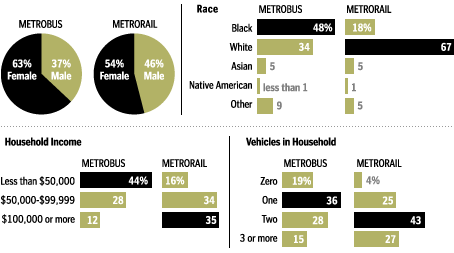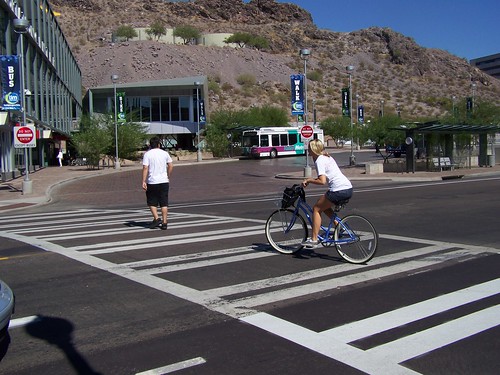Preference for light rail service over bus is not always the case: Sacramento and Elk Grove
 Transit rider demographics, Washington DC region, circa 2005, Washington Post graphic.
Transit rider demographics, Washington DC region, circa 2005, Washington Post graphic.While research about willingness and actual use of transit finds the wealthiest use railroad, the next wealthiest subway, and the least economically well off use the bus, this is not categorical.
The reality is that in the US, mobility is dominated by the car, and only about 5% of daily trips are conducted by transit. in most of the US, transit is seen more as a "social service" provided to people who can't afford to drive ("Public Transportation’s Demographic Divide," Governing Magazine).
It is true that generally, riders tend to be poorer, even though major cities designed around rail-based transit, such as New York City, San Francisco, Boston, Philadelphia, Chicago, and Washington have extensive transit systems that draw higher income riders.
So we shouldn't be surprised that in most regions of the country, higher income residents aren't big on supporting transit, let alone riding it.
For example, around Baltimore and Anne Arundel Counties, many higher income residents refer to light rail as "loot rail," believing that Baltimore City residents come out to their counties to commit crimes--and because of the routing of the line and the location of the stations, higher income residents aren't particularly well-served and inclined to use the service.
Some residents in Anne Arundel County even called for the closure of one of the station, ("Some Linthicum residents want to close light rail station over crime," Baltimore Sun), although their effort was unsuccessful.
Something not dissimilarly is happening in Elk Grove, California, a suburb of Sacramento that has its antecedents as a farming community, and became an incorporated city in 2000.
According to the Sacramento Bee ("Elk Grove commuter question: To ride light rail or not?"), the Sacramento Rapid Transit (RT) system is being extended by 4.3 miles to serve Cosumnes River College, a community college located at the edge of Elk Grove.
For many years, the city has run a bus service which moves about 1,000 residents to the city and back--after opting out of the RT district they fund their own service, which is running at a deficit. The e-tran bus service isn't eligible to receive monies from the county transit sales tax.
The city thought that the light rail extension could allow them to drop service between Elk Grove and Sacramento, instead moving people to and from the light rail station.
But 80% of the residents surveyed are against the move, in large part because of fear. From the article:
For the moment, the fear factor looms large among e-tran riders. At a recent public meeting, some were blunt in saying they feared for their safety if they rode the train. Elk Grove City Councilman Darren Suen also attended the meeting.
“What I heard loud and clear is that the perception of light rail is that it’s unsafe, it’s unclean and it’s inconvenient,” Suen said. The question, he said, is “How do we make it safe, clean and more convenient? That’s what we need to shoot for, but we’re going to need regional help. We’re going to need RT’s help.”The RT is willing to create limited stop service on the extension, to make the trip downtown faster.
Depending on where the residents live, compared to bus, the trip by light rail can be made in half the time.
The mayor suggests that if residents aren't willing to make the shift now, the concept of the shift can be raised again, after the service is in operation and more people become familiar with it.
He also wants light rail to be extended to the city's downtown, about 5.5 miles from the community college, making the light rail service more central and even easier to use.
I think that's a reasonable course. Even though it's funny that people already using transit are afraid to use a different form of it. And the city is still going through its maturation process. For example, there has been a mayor directly elected by citizens only since 2012--previous mayors were selected by the City Council and served one year terms.
Elk Grove and its transit future: Tempe as a model to emulate. Interestingly, despite the opposition now for shifting from bus to light rail, in the long term the city has the opportunity to rebrand and reposition around fixed rail transit service as a way to differentiate the city vis-a-vis other communities in the metropolitan area.
The best sister city Elk Grove could have in terms of transit is Tempe, Arizona. While Tempe has a large state university, Arizona State, otherwise the cities are about the same size (about 40 square miles) and the same population (a bit more than 160,000), and about a similar distance from the community to the downtowns of their respective metropolitan areas.
 A pedestrian and cyclist in the crosswalk moving towards the Tempe Transportation Center, with a Valley Metro bus in the distance.
A pedestrian and cyclist in the crosswalk moving towards the Tempe Transportation Center, with a Valley Metro bus in the distance.Tempe has one of the best transportation agencies in the US for a city of its size. It has a free transit system called Orbit, which moves people from neighborhoods to activity centers, a light rail station at the city's multi-modal Transportation Center, and regional bus service from Valley Metro, a great transportation demand management program, overseen by the city's Transportation Commission.
========
In other Sacramento transit news, property owners in downtown voted in favor of paying towards and adding streetcar service ("Property owners vote for Sacramento streetcars," Sacramento Bee),not unlike how the NoMA subway "infill" station was funded in DC (NoMa-Gallaudet U Metro Study: Success Built on Transit).
Labels: fixed rail transit service, public safety, transit, transit marketing





5 Comments:
https://medium.com/matter/inside-the-bubble-bus-87ca7e027c1
Bus, in europe, can be more upscale than subway. Goes into middle class areas more and has natural light.
interesting. a la bridj. There are always going to be some potential routes out there that could be "successful" with commuter bus like pricing. Whether there are enough potential riders to pay for the capital cost of a bus, plus the high operating costs of personnel, plus maintenance etc. on regular routes is another question.
cf. the attempt at a commuter bus in Toronto, paralleling a highly used overcapacity line, just like the line in SF
http://www.cbc.ca/news/canada/toronto/liberty-village-shuttle-bus-axed-1.2916451
interesting points from the bus.
Prepaid smartphone tickets that tell the driver when the pick you up.
QR or bluetooth reading. Much simpler than NFC. QR codes can be very quick if done correctly.
Basicaly 2x the price for space and no homeless people on the bus.
and even at double the price (presuming there are no discounts for passes, etc.) of the regular bus, a round trip is still only 1/3 or less of the cost of owning and parking a car in SF.
Thank you again for your flawless service, and I look forward to working with you in the future.
Post a Comment
<< Home